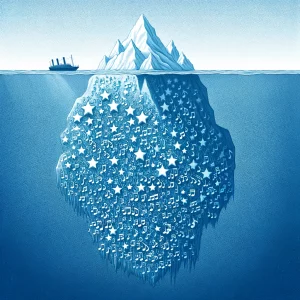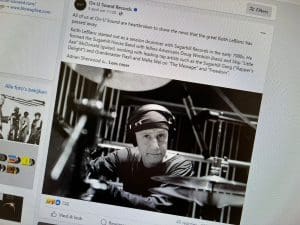Synthwave: One of Many Internet Created Music Genres


Synthwave, not to be confused with retrowave or vaporwave (which we will discuss later) is a genre of music that was created in large parts by the internet. Beginning in the early 2000s, niche and highly creative internet communities, who were heavily nostalgic for 1980s culture, helped create gave a name to a genre of music that would remind them of their childhood and celebrate the era’s atmosphere.
Synthwave is heavily influenced by retrofuturism, a movement that showcases depictions of the future produced in an earlier era. For example, 1960s America depicted flying cars by the turn of the millennium. Retrofuturism is the remembering of the anticipation and being nostalgic for the anticipation that is often shown to be naïve in hindsight.
The thousands of anonymous Synthwave creators were inspired by 1980s films, video games, cartoons and music. The 2011 film Drive starring Ryan Gosling featured a soundtrack spotlighting several Synthwave artists – more on this later.
Synthwave, Retrowave and Video Games
Although sometimes confused as the same thing, Retrowave is a bit like the precursor to the more ‘synthy’ Synthwave. The soundtrack of the Sonic the Hedgehog video game is very retrowave, indeed the soundtrack of many 80s and 90s video games have heavy Retrowave elements to them – although nobody has properly been able to label a specific genre onto the soundtrack of Sonic the Hedgehog. Taking Sonic the Hedgehog as an example, the composer of the games soundtrack, Masato Nakamura was limited in what he could do – this being the early 90s. Nakamura was restricted as to the number of sounds that could be played concurrently; this number being four. However, what transpired was the imaginative use of the FM synthesizer which helped to create unique and enjoyable music.
The FM synthesizer helped composers to create original and catchy compositions, mixing together house, techno, trance and electronic textures that advanced video games from R2D2 like beeps and boops to music that would not sound unusual in a night club. Some of the smartest minds in science and technology were working in the video game industry during the 80s and 90s and the uniqueness of the video games during these decades showcases that. Without a doubt, the soundtracks of video games such as The Revenge of Shinobi, Sonic and Streets of Rage were crucial in the genre of music we now know as Synthwave.
The influence of 80s films
Eighties films were instrumental to the Synthwave genre. Scarface, Bladerunner and Chariots of Fire are three eighties films with extremely synthy soundtracks. These three films were so original in just about every aspect; from the stories they told to their soundtracks. Like the video game soundtracks of the time, there was no real name or genre that could be labelled to this style of music – it was a mix of several different types.
It is no surprise that during the early days of the internet, chatrooms were occupied with people keen to express their enjoyment of 80s culture. The 80s was a decade of innovation in film and technology – the amount of inspiration generated by the eighties is unmeasurable. Of course, every generation is nostalgic about the period they grew up in, but Synthwave owes the eighties everything. Synthwave artist of the early 2000s took a lot of their inspiration from the music in the aforementioned popular eighties films.
Synthwave Now
Here and now in 2019, Synthwave has never been more popular and again, a lot of it is due to the internet and advancements in technology. The wide availability of music producing and mixing equipment as well as video and stream sharing platforms such as YouTube and Souncloud, have allowed any person with an internet connection and a passion for Synthwave to create and share their own songs. Type Synthwave into the YouTube search bar and you will find thousands of songs. Do the same on Spotify and you encounter the same result; playlists full of synthwave and its popularity is only growing.
The aforementioned 2011 movie Drive became a cult hit thanks partly due to its Synthwave soundtrack. There is famously a lack of verbal communication in the film with the director, Nick Refn preferring to convey feelings and emotions through the use of visuals and music. Due to the main characters (played by Ryan Gosling) lack of dialogue, the audience is in a constant state of wondering what he will do next. “The Drive soundtrack is such an integral part of the experience of the film, once you see it, you can’t imagine the film without it,” stated one film critic from the Boston Herald. The Synthwave soundtrack of the film was released as an album and managed to climb to number four on the iTunes sales charts. The soundtrack was even included on Spin magazine’s list of 40 Movie Soundtracks That Changed Alternative Music, such was the strength of the album.
The video game Hotline Miami was released a few months after Drive hit the cinema screens and shared lots of similarities with the film. So much so that a lot of the game’s success was due to the fact that fans of the film wanted a similar game to play and therefore bought Hotline Miami. With a stylized period setting and a soundtrack full of Synthwave artists, Hotline Miami matched Drive in many positive ways. More recently, an ever-growing number of indie developers are creating niche video games that use neon styles mixed with Synthwave music soundtracks. This combination often gives video games both an edgy and a hyper-stylised feel that is original and often completely different to modern video games. Online casinos are also making use of the surge in popularity of Synthwave music. A variety of online slots games in the UK and abroad are now designed with highly stylised graphics in combination with a Synthwave tracklist. One such game is Neonstaxx which is akin to the slot version of Drive. Slots games have two main elements, visual and audio and it is important for casino game developers to choose two elements that fit together and that players will enjoy.
Vaporwave and Internet Meme Genres
Vaporwave emerged in the early 2010s through the influence of electronic music and internet memes. Vaporwave is seen as a satire of consumerist culture and as a critique of electronic dance music which became mainstream in the 2000s. Vaporwave is close to synthwave and could be considered an evolution of the former, although they both have differences. Vaporwave has been described as an art and has its own niche following. Pitchfork contributor Jonny Coleman described Vaporwave as “the uncanny genre valley” that lies “between a real genre that sounds fake and a fake genre that could be real.”
More recently, internet meme culture created an avant-garde music genre known as Gachi, stemming from the Japanese word gachimuchi which means muscular. Gachi challenges the heteronormative rules of modern music. Early Gachi music was known as ‘gayrolling’ a form of rick’rollin. As these videos became more and more popular, other Gachi videos and music came out. When gay pornographic film actor Billy Herrington aka Aniki became an internet meme, internet users began to use him in videos and up until 2019, over 100,000 short mash-up parodies of his scenes have been produced by fans – these mash-up parodies are Gachi and Gachi music and videos are building a following thanks to internet meme culture.
Since you’re here …
… we have a small favour to ask. More people are reading Side-Line Magazine than ever but advertising revenues across the media are falling fast. Unlike many news organisations, we haven’t put up a paywall – we want to keep our journalism as open as we can - and we refuse to add annoying advertising. So you can see why we need to ask for your help.
Side-Line’s independent journalism takes a lot of time, money and hard work to produce. But we do it because we want to push the artists we like and who are equally fighting to survive.
If everyone who reads our reporting, who likes it, helps fund it, our future would be much more secure. For as little as 5 US$, you can support Side-Line Magazine – and it only takes a minute. Thank you.
The donations are safely powered by Paypal.







